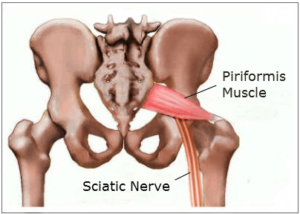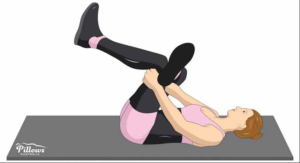What is Piriformis Syndrome and what does that have to do with sciatic pain?
Piriformis syndrome is the compression of the sciatic nerve by the piriformis muscle, leading to sciatic pain. The Piriformis is located in the gluteal region, attaching from the sacrum (lower lumbar spine) to the top of your femur.
“Conditions affecting the sciatic nerve that refer pain down the posterior thigh are often referred to by the general public as sciatica. This term is not specific, because it may refer to inflammation of the nerve or compression of the nerve in the lumbar spine, in the gluteals or at another distal point along the pathway of the nerve.”-(Linda Ludwig)
The sciatic nerve supplies sensory and motor function to the skin and muscles to the back of the thigh, most of the leg and the foot.

So what causes piriformis syndrome? There are a number of reasons you may be suffering from this.
- Trauma: Such as a fall on the buttocks or a motor vehicle accident. These can lead to inflammation and spasms resulting in scar tissue and adhesions.
- Inflammation: from say arthritic of the hip joint or post hip replacement swelling
- Overuse: Repeated actions of bending and lifting, or squatting with weight, running
- Postural imbalances: Sitting in a position that shortens the muscle for prolonged periods, like driving long distances or sleeping on your abdomen, since we tend to lift one knee up and rotate it outwards.
- Pregnancy in the 3rd trimester: When the belly shifts the center of gravity forward, it pulls the low back forward into a greater lumbar curvature, as well as forcing the hips to rotate externally, (outwardly) causing the glutes to be overstretched and tight. The tight muscles then push the nerve against the bone.
So how can massage help Piriformis syndrome?
By treating the tightened piriformis and its surrounding muscles to loosen it’s pressure on the sciatic nerve. In doing so, any misalignment in the pelvis should be addressed as well. This can sometimes be treated by the RMT or in coordination with a chiropractor.
Caring for sciatic pain at home is necessary too. There are a number of things we can do at home to prevent and treat this.
- StretchPlacing your ankle over the opposite knee, pull the thigh towards your chest. Hold for 30-60 seconds.

Using a tennis or street hockey ball, place it between your piriformis and the floor or the wall in the spot of tolerable discomfort. Hold in place until discomfort dissipate. Re-adjust if feeling numbness or tingling down the leg, as you want to avoid placing pressure directly on the nerve.2. Take frequent breaks:
When driving long distances or sitting at a desk, take breaks to go for short walks or stretch every hour or so.
3. Place a pillow between the knees to keep the muscle in neutral and avoid aggravating the shortened muscle.
4. Modify sitting positions: Avoid sitting on the foot and rolling the knees out to the side, but keep the knees and feet in midline.
Blog by: Tara Ottosen, RMT
